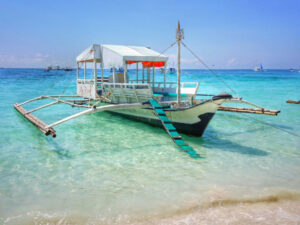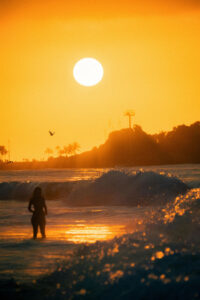There’s something about Zambales that slows you down in the best way. Maybe it’s the salt air carried by the West Philippine Sea, or the rhythm of waves that crash gently along miles of unspoiled coast. Just a few hours from Manila, this province has become one of my favorite places to escape — a mix of raw beaches, surf-friendly towns, and sleepy fishing villages that remind you what island life feels like when you strip away the noise. This Zambales travel guide is my love letter to the coast — written after countless weekends spent exploring its coves, tasting its food, and falling in love with its quiet resilience.
Getting There
The easiest way to reach Zambales is by land from Metro Manila. I usually take a bus from Cubao or Pasay to Iba or Santa Cruz — the ride takes about four to five hours, depending on traffic. If you’re heading to the surf towns of San Narciso or San Felipe, it’s best to hop off earlier, around two to three hours into the journey. For a more comfortable trip, private vans and car rentals can be booked through Klook, making it easy to customize your stops along the way.
Zambales is blessed with sunshine most of the year, but the best time to visit is from November to May when the sea is calm and the skies are clear. Surfers usually flock between July and October when southwest winds bring consistent swells. I personally love visiting during the shoulder months — fewer tourists, but the same breathtaking scenery.
Top Beach Escapes
 The coast of Zambales stretches for more than 170 kilometers, and every few towns, you’ll find a beach that feels worlds away from the rest. Each has its own character — from serene camping coves to adventure-ready islands.
The coast of Zambales stretches for more than 170 kilometers, and every few towns, you’ll find a beach that feels worlds away from the rest. Each has its own character — from serene camping coves to adventure-ready islands.
Nagsasa Cove
The first time I camped at Nagsasa Cove, I woke up to a view that didn’t seem real. The sand shimmered silver under morning light, mountains rose dramatically in the background, and the water was calm as glass. There’s no phone signal, no resorts — just nature, peace, and the sound of the sea. Most travelers reach it via a 45-minute boat ride from Pundaquit in San Antonio. Bring your own tents or stay in one of the small local-run campsites offering basic amenities and fresh seafood cooked over charcoal.
Anawangin Cove
Just next door, Anawangin Cove is more accessible but equally stunning. It’s known for its pine tree-dotted shoreline — a surreal mix of mountains and beach that feels like no other place in Luzon. I remember hiking up one of the nearby viewpoints to catch the sunset — the sky turned gold, the cove below glowing like an ember. You can reach it by boat or through a short trek from Barangay Pundaquit. It’s a popular weekend spot, so weekdays are best if you crave solitude.
Capones Island
Off the coast of San Antonio, Capones Island is a rocky paradise crowned by an old Spanish lighthouse. I hiked up the hill to the lighthouse ruins one summer afternoon, wind whipping through my hair, sea stretching endlessly below. The climb is steep, but the panoramic views make every step worth it. Snorkeling here reveals coral gardens and schools of fish — proof that Zambales’ beauty doesn’t end onshore.
Potipot Island
Farther north in Candelaria, Potipot Island offers powdery white sand and calm waters — perfect for swimming or picnicking. I loved walking around its small perimeter, barefoot and carefree, with the sea on both sides. It’s ideal for families or day-trippers looking for an island experience without venturing too far.
Crystal Beach
Of course, no Zambales travel guide would be complete without mentioning Crystal Beach in San Narciso. It’s where surf culture and relaxation meet. I’ve spent lazy afternoons here in a hammock, watching surfers ride playful waves under streaks of orange sky. The resort’s bamboo huts and rustic vibe give it a carefree energy that perfectly captures the spirit of Zambales.
Surf Town Vibes: San Narciso and San Felipe
 If Nagsasa is where you go to unplug, San Narciso and San Felipe are where you go to connect — with people, with music, with waves. These neighboring towns have grown into the heart of Zambales’ surf culture.
If Nagsasa is where you go to unplug, San Narciso and San Felipe are where you go to connect — with people, with music, with waves. These neighboring towns have grown into the heart of Zambales’ surf culture.
In San Felipe, I stayed at Liwa Beach, a haven for surfers, artists, and travelers chasing sunsets. The vibe here is refreshingly local — surf schools line the shore, offering beginner lessons for as low as ₱400 per hour. After surfing, I grabbed a smoothie bowl from The Circle Hostel’s café and joined a group of backpackers jamming to acoustic guitars under palm trees. It’s the kind of place where strangers become friends before the day ends.
San Narciso, on the other hand, feels a bit quieter but equally charming. Its Crystal Beach Resort offers good waves, beachfront bonfires, and live music on weekends. Surf season runs strongest from July to November, but even in calmer months, it’s worth visiting for the chill ambiance and the scent of bonfire smoke mingling with the sea breeze.
Nature & Adventure
Zambales isn’t just about beaches. Its mountains and rivers hold their own kind of magic. One of the most iconic adventures in this Zambales travel guide is the Mount Pinatubo trek. The journey starts from Capas, Tarlac, but many tours pass through Zambales’ side trails. Riding through the ash fields by 4×4 feels like traveling through another planet — gray landscapes framed by green ridges. The reward? A turquoise crater lake that glows under the sun, serene and almost sacred.
Closer to the coast, you’ll find hidden waterfalls like Botolan’s Tukal Tukal Falls and San Felipe’s Anghalo Falls, perfect for cooling off after a morning hike. For eco-tourists, Subic Bay offers mangrove parks, butterfly gardens, and guided forest walks. I joined a kayaking tour through the Subic Mangrove Trail and was amazed at how peaceful the estuary felt — egrets perched on roots, water gliding silently under the trees.
Food & Culture
Zambales’ food scene is simple but soulful. Along the coast, seafood reigns supreme — grilled squid, shrimp sinigang, and freshly caught fish served with sweet mangoes. In Liwa, I stumbled upon a beach shack called Kwento’s, where the owners served grilled liempo and cold calamansi juice while telling stories of how they built their surf school from scratch. These little community spots define Zambales dining — casual, heartfelt, and always shared.
At the San Antonio Public Market, I found stalls selling pinais (fish wrapped in banana leaves) and tinapa (smoked fish) that make perfect take-home treats. And if you visit Subic Bay, don’t miss Xtremely Xpresso Café for its brick-oven pizza and signature frappes — a modern contrast to the coastal simplicity just beyond the bay.
The warmth of Zambales doesn’t just come from the sun — it’s from the people. Fishermen who wave at you from their boats, kids who offer seashells as souvenirs, and locals who invite you to share their food even when you’re a stranger. It’s these small gestures that make the province unforgettable.
Where to Stay
From budget-friendly campsites to chic eco-lodges, Zambales caters to every kind of traveler. In San Felipe, The Circle Hostel is a favorite for backpackers — colorful murals, open bunks, and a community vibe that encourages connections. For those craving comfort, Liwa Beach Resort and Kapitan’s Liwa offer cozy cottages steps away from the surf.
In San Narciso, Crystal Beach Resort provides beachfront glamping tents and modern villas. Up north, Potipot Gateway Resort in Candelaria combines island access with resort amenities. And for travelers who prefer Subic’s convenience, Camayan Beach Resort and ACEA Subic Bay balance relaxation and accessibility.
Each stay adds its own flavor to your journey — from star-filled nights in Nagsasa to laughter-filled bonfires in Liwa. Wherever you choose, the sea is never far, and the sound of waves will always be your lullaby.
Why Zambales Captures the Heart
 As I watched the sun dip behind the sea at Nagsasa Cove, painting the horizon in hues of amber and violet, I realized that Zambales is more than a destination — it’s a feeling. A reminder that paradise doesn’t need perfection, only presence. Here, you can surf at sunrise, hike by noon, and share stories over grilled fish by sunset.
As I watched the sun dip behind the sea at Nagsasa Cove, painting the horizon in hues of amber and violet, I realized that Zambales is more than a destination — it’s a feeling. A reminder that paradise doesn’t need perfection, only presence. Here, you can surf at sunrise, hike by noon, and share stories over grilled fish by sunset.
This Zambales travel guide is proof that you don’t have to go far to find something extraordinary. Just hours from Manila lies a coast that invites you to slow down, breathe deeply, and reconnect — with nature, with people, and with yourself.
For more coastal inspiration, check out our guide to the best beach resorts on Luzon Island, or explore official tours and eco-adventures through the Department of Tourism.
Zambales isn’t just a weekend escape — it’s a living rhythm of sea and sky, of laughter and stillness. Come with curiosity, leave with peace. That’s the magic of Zambales — the coast that always calls you home.

